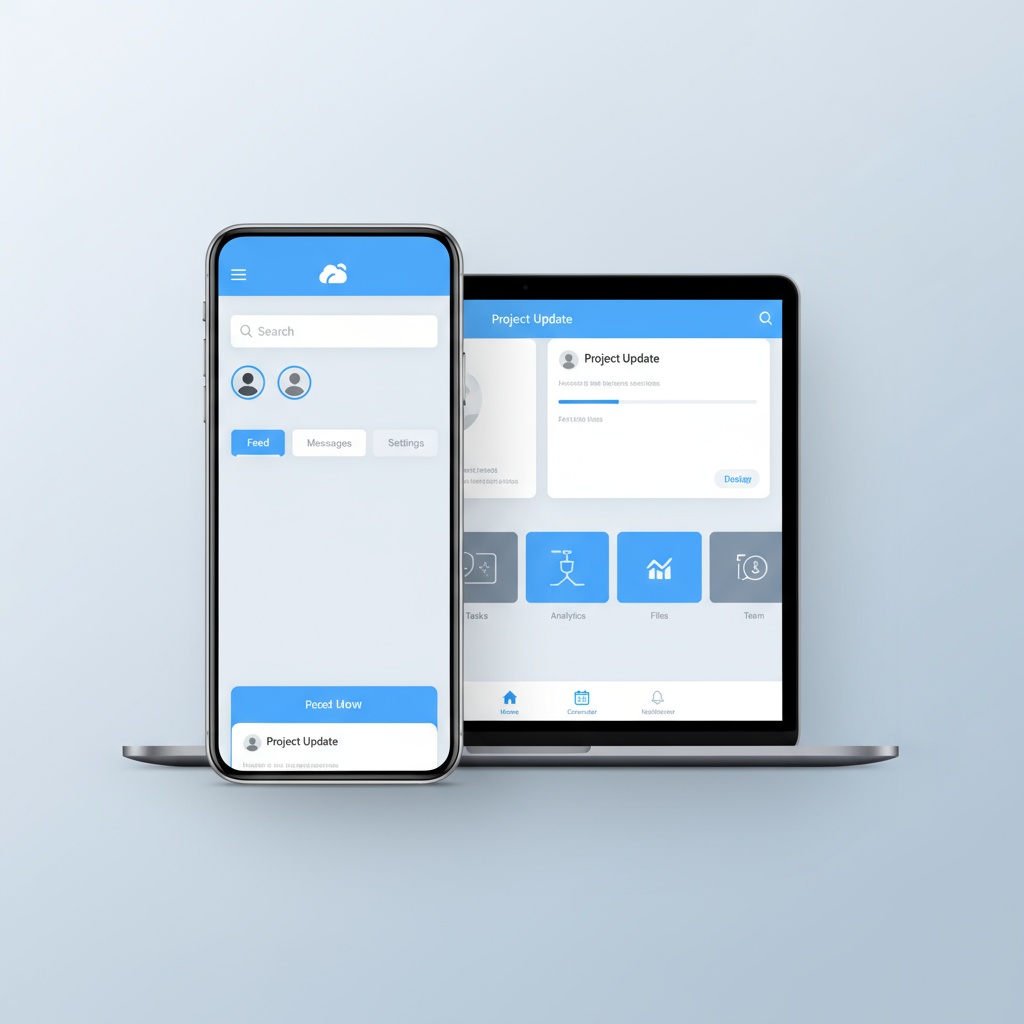Apple has built an ecosystem that influences how millions of people work, shop, and communicate. iOS applications sit at the center of this system, and businesses that invest in them early tend to stay ahead of competitors.
Entering 2025, the market is shifting quickly. Global consumer spending on mobile apps surpassed $170 billion in 2023 according to Data.ai, and iOS apps accounted for a large share of that revenue.
The coming year is expected to bring even stronger demand, not just for entertainment and lifestyle apps, but also for enterprise solutions across healthcare, retail, and fintech.
Evolving Apple Ecosystem in 2025
Apple, as an organization, has always been criticised for whatever they have done. But technology enthusiasts and consumer market experts are now realizing that the focus that Apple brings is for its own ecosystem.
Apple is working hard to refine and improve the Apple ecosystem and most of its updates and innovations are centered on that, rather than following what its competitors are doing.
iOS 19 and Beyond
Apple’s next iOS iterations are likely to introduce deeper personalization, improved security layers, and tighter integration with other Apple devices.
Analysts expect Apple to continue building features around privacy, an area where the company already leads.
Reports from Statista show that over 70% of iOS users updated to the latest iOS version within months of release, which makes adopting new standards critical for app success.
Integration with Vision Pro and Spatial Computing
Apple Vision Pro, launched in early 2024, has already started shaping expectations for spatial applications. iOS developers in 2025 must be ready to connect mobile experiences with AR and VR capabilities, giving users an immersive way to interact with apps.
Known publications around the globe have highlighted that Apple invested heavily in expanding developer tools for Vision Pro, indicating stronger cross-platform use cases are on the horizon.
Privacy and Security Expectations
Apple continues to prioritize privacy as a core selling point. Stricter App Tracking Transparency rules and new data permission frameworks are being tested for rollout.
A survey by Pew Research revealed that 79% of Americans remain concerned about how companies use their personal data, and Apple’s position as a “privacy-first” brand means every iOS app must meet high standards in 2025.
Developers who fail to adapt risk rejection during App Store review.
Seamless Device Ecosystem
Cross-device experiences will grow even more seamless.
Users expect iPhone, iPad, Apple Watch, and Mac applications to work together without friction. In 2025, businesses planning to build only for iPhone will likely lose ground to competitors offering multi-device support.
Software Orca focuses on development strategies that unify these devices, ensuring businesses reach users wherever they interact with the Apple ecosystem.
Design and User Experience in 2025
Apple has always been heavily focused on how its products are designed. Their focus (read obsession) with their digital and physical products have made them an outlier in a market, which is now beginning to follow Apple’s trail.
Adaptive Interfaces for New Devices
The iOS ecosystem is expanding into foldable screens, spatial devices, and mixed-reality hardware. Developers cannot rely on static design principles anymore.
A report on mobile innovation found that over 90% of consumers expect apps to adapt seamlessly across new form factors. iOS app design in 2025 will require layouts that respond dynamically, not only to screen sizes but to entirely new modes of interaction.
Human-Centered Design and Accessibility
Apple continues to lead in accessibility standards. VoiceOver, haptic feedback, and dynamic text scaling are already integrated across iOS. In 2025, these tools are not optional add-ons but baseline expectations.
According to the World Health Organization, 1 in 6 people globally live with a disability. Businesses that fail to make their iOS apps accessible risk alienating large user groups and facing reputational setbacks.
Software Orca’s design process treats accessibility as a core pillar, ensuring that products comply with Apple’s Human Interface Guidelines and global accessibility benchmarks.
AR-Enhanced Experiences
As augmented reality becomes more mainstream, iOS apps will increasingly merge digital layers with the physical world. Statista forecasts the global AR market to reach $46 billion by 2025, with iOS devices capturing a significant portion of that adoption.
Brands that integrate AR into retail, training, or entertainment apps will stand out. The design challenge is to keep interfaces intuitive while offering advanced immersive features.
iOS App Development Trends and Tech Stack Changes
Investors and founders are ever more enthusiastic about their ideas, especially after the inception of AI. They want to find an iOS app development company that understands their business, and focuses on what is trending around the globe.
The Rise of Swift and SwiftUI
Swift continues to dominate iOS app development. In Stack Overflow’s Developer Survey 2024, Swift ranked among the top 20 most loved programming languages.
SwiftUI, Apple’s modern UI toolkit, is now favored for new projects due to its declarative syntax and faster development cycles. UIKit still exists for legacy apps, but developers in 2025 are encouraged to transition toward SwiftUI for scalability and smoother updates.
Advanced Machine Learning Integration
Apple has steadily expanded its Core ML and Create ML frameworks, giving developers direct access to powerful on-device intelligence.
Gartner predicts that over 80% of smartphones shipped in 2025 will have dedicated AI accelerators, and Apple devices are at the front of this shift, leading with Apple Intelligence.
iOS developers must now think about predictive text, image recognition, and natural interactions as default features in new applications.
Cloud-Native Development and CI/CD Adoption
App development pipelines are no longer confined to local builds. Cloud-native workflows let developers collaborate globally, test faster, and release updates in real time.
According to JetBrains’ 2024 State of Developer Ecosystem report, 60% of mobile developers use CI/CD pipelines in their workflow. In 2025, this number will rise further as businesses demand frequent updates with zero downtime.
Software Orca helps companies integrate these pipelines into their iOS projects, allowing faster releases and reliable scalability.
Stronger Security Frameworks
iOS apps in 2025 must comply with stricter App Store checks and security audits. End-to-end encryption, biometric authentication, and zero-trust design are becoming baseline requirements.
Cybersecurity Ventures reports that cybercrime costs will hit $10.5 trillion annually by 2025, making secure iOS development a business necessity rather than an optional feature.
Monetization and Business Models in 2025
Monetization in iOS app development is shifting toward recurring subscriptions, microtransactions, and enterprise-focused solutions. Businesses adopting these models in 2025 gain stronger revenue streams and long-term user retention.
Subscription Economy Keeps Growing
Subscriptions remain the dominant monetization model on iOS. Users now expect recurring plans that unlock features, offer premium access, or remove ads. Companies investing in iOS apps must think of sustainable subscription strategies that deliver continuous value.
Microtransactions and In-App Purchases
In-app purchases will continue driving revenue, especially in gaming and lifestyle applications. These models extend beyond gaming into fitness apps, learning platforms, and retail experiences where users unlock exclusive digital goods or services. Businesses that plan ahead can tap into this consistent revenue flow.
Enterprise App Growth
Enterprises are investing more in custom iOS apps for field work, healthcare, logistics, and finance. Enterprise applications bring efficiency, data integration, and security, giving iOS development companies like Software Orca a clear opportunity to provide high-value solutions for business-critical environments.
Compliance and Privacy Landscape
The compliance and privacy landscape in 2025 demands stricter adherence to Apple’s App Store policies and global data regulations. Businesses must build iOS apps with transparency, security, and user trust at the core.
Stricter App Store Policies
Apple continues tightening its rules around app review and publishing. In 2025, businesses should expect even closer scrutiny, particularly in areas involving data collection, payments, and child protection. Developers must align with Apple’s evolving policies to avoid delays or costly rejections.
Data Protection Standards
Privacy remains central to Apple’s market position. Features like App Tracking Transparency, introduced earlier, now come with extended enforcement.
Businesses developing iOS apps in 2025 need to show clear transparency in permissions and adopt secure handling practices. Non-compliance not only risks App Store removal but also damages customer trust.
Global Regulations Impacting iOS Apps
The regulatory environment is becoming more complex. Europe’s GDPR, California’s CCPA, and the EU’s AI Act are reshaping how data is managed and processed in mobile applications.
The iOS ecosystem must adapt to these changes quickly, as regulators continue introducing penalties for non-compliant businesses. Partnering with experienced iOS developers like Software Orca helps organizations navigate legal standards while building user trust.
Opportunities for Businesses in iOS Development
iOS development in 2025 offers businesses new ways to capture market share through early adoption, enterprise solutions, and privacy-first design. Companies that move quickly will strengthen engagement, revenue, and long-term customer loyalty.
Staying Competitive with Early Adoption
Early adoption of Apple’s latest frameworks gives businesses a strategic advantage. Data shows that apps that adapt within the first six months of an iOS release see 30% higher engagement rates compared to slower adopters. In 2025, companies that build with SwiftUI, AR integration, and privacy-first design will set the tone in their industries.
Expanding into New User Segments
The iOS market extends beyond consumer-facing apps. Enterprise mobility is gaining momentum as organizations demand tools for internal operations. Sectors like healthcare, logistics, and financial services are adopting iOS solutions to manage workflows, security, and customer engagement. Businesses tapping these areas in 2025 can position themselves as leaders in digital transformation.
Strengthening Trust Through Privacy
User trust has become a competitive advantage. Research from Cisco’s Consumer Privacy. Aligning with Apple’s privacy framework not only avoids compliance issues but also builds stronger relationships with customers. Companies investing in iOS apps that highlight data security and transparency will win greater loyalty.
How Software Orca Supports iOS Development in 2025
Software Orca, as a leading iOS app development company, delivers future-ready iOS apps built on SwiftUI, AR, and secure frameworks. Our team helps businesses innovate, stay compliant, and scale faster with custom iOS development services designed for growth in 2025 and beyond.
Expertise in Custom App Development
Software Orca delivers tailored iOS solutions that address both consumer and enterprise needs. Teams focus on Swift and SwiftUI to build apps that perform across devices, ensuring compliance with Apple’s design and privacy standards.
Integration with Apple’s Expanding Ecosystem
From Vision Pro experiences to cross-device functionality, Software Orca helps businesses navigate Apple’s evolving ecosystem. Clients benefit from strategies that extend apps beyond the iPhone, creating value across iPads, Watches, and Macs.
Security and Compliance First
Data security sits at the core of Software Orca’s development process. Strict adherence to App Store guidelines, global privacy regulations, and advanced security frameworks protects businesses from rejection and reputational risks.
Scaling for Growth
CI/CD pipelines, cloud-native testing, and modern DevOps practices are embedded in Software Orca’s approach. Businesses gain apps that scale quickly and update reliably, which supports long-term growth without compromising stability.
Wrapping Up
iOS app development in 2025 is defined by fast-moving technology, stricter compliance, and new opportunities in both consumer and enterprise markets. Apple’s ecosystem continues to grow, and businesses that adapt early gain measurable advantages in engagement, revenue, and customer trust.
Software Orca stands as a partner for companies preparing to build or modernize iOS applications. With expertise in design, development, compliance, and scaling, the team ensures that businesses are not just keeping pace but moving ahead.
The year ahead is not about waiting to see what changes Apple brings. It is about preparing now, so that when the shifts arrive, your app is already ready for them.
Frequently Asked Questions
Q1. What are the top iOS app development trends in 2025?
The leading trends include SwiftUI adoption, AR experiences, subscription monetization, cross-device support, and stricter privacy compliance. Businesses must prepare apps that adapt to Apple’s evolving ecosystem and user expectations.
Q2. Is Swift still used for iOS app development in 2025?
Yes. Swift remains Apple’s core programming language for iOS. SwiftUI is now preferred for new projects, offering faster builds, better design integration, and smoother updates compared to legacy frameworks like UIKit.
Q3. How does Apple Vision Pro affect iOS app development?
Vision Pro introduces spatial computing to Apple’s ecosystem. iOS developers must create applications that integrate AR and VR, offering immersive experiences across iPhone, iPad, and new Apple hardware.
Q4. What monetization models work best for iOS apps in 2025?
Subscriptions and in-app purchases lead revenue growth. Enterprise-focused apps are also expanding, helping businesses increase efficiency and revenue through custom solutions.
Q5. How can businesses stay compliant with iOS app privacy rules?
Apps must follow Apple’s App Store guidelines, adopt transparent data permissions, and align with regulations like GDPR, CCPA, and the EU AI Act. Working with experienced developers ensures compliance and faster approval.






